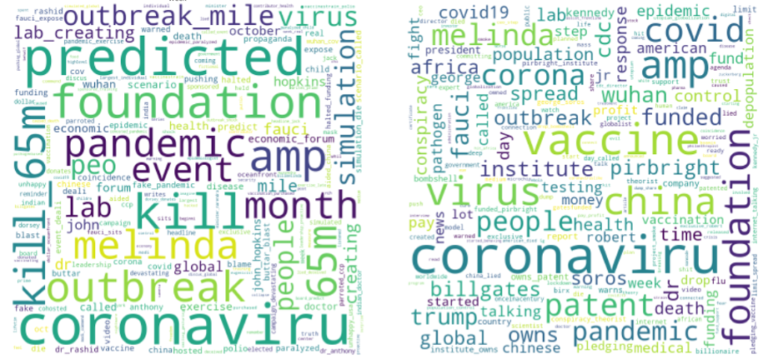Researchers used a new artificial intelligence program to accurately identify COVID-19 related conspiracy theories on social media and model how the misinformation evolves in a recently published study. Researchers say the tool could ultimately help public health officials in combating dangerous online misinformation.
The use of AI or machine learning to identify different types of online conspiracy theories isn’t new. In 2019, computer scientists at the University of Washington and Allen Institute for AI announced they had developed a new system called Grover that could identify convincing fake news stories with an accuracy rate of 92%.
Limited research, however, has been done in using AI to understand how conspiracy theories grow, mutate, and evolve into complex systems of belief.
“We wanted to create a more cohesive understanding of how misinformation changes as it spreads,” Courtney Shelley, a postdoctoral researcher in the Information Systems and Modeling Group at Los Alamos National Laboratory and co-author of the study, said in a press release.
“Because people tend to believe the first message they encounter, public health officials could someday monitor which conspiracy theories are gaining traction on social media and craft factual public information campaigns to preempt widespread acceptance of falsehoods.”


The study published in the Journal of Medical Internet Research used open-source data from Twitter to identify patterns and offer context for four COVID-19 related conspiracies that emerged from January to early May 2020.
The four conspiracy theories examined by researchers were that the Bill and Melinda Gates Foundation engineered the virus; that 5G cell towers spread COVID-19; that the virus was bioengineered or developed in a laboratory; and that COVID-19 vaccines currently being developed would be dangerous.
“We began with a dataset of approximately 1.8 million tweets that contained COVID-19 keywords or were from health-related Twitter accounts,” said Dax Gerts, a computer scientist at Los Alamos’ Information Systems and Modeling Group and co-author of the study. “From this body of data, we identified subsets that matched the four conspiracy theories using pattern filtering, and hand-labeled several hundred tweets in each conspiracy theory category to construct training sets.”
Using the collected data on each of the four conspiracy theories, researchers built random forest machine-learning or AI models that would categorize tweets as being COVID-19 misinformation or not. Through this model, researchers observed how people talked about the conspiracy theories on social media and how the ideas changed over time.
Ultimately, researchers found that misinformation about the pandemic tended to contain more negative sentiment when compared to factual tweets. Perhaps unsurprisingly, AI models found that the conspiracy theories evolve and incorporate details from other unrelated conspiracy theories and real-world events.
Researchers also noted frequent overlaps with unrelated COVID-19 conspiracies. For example, the theory that COVID-19 was bioengineered in a lab showed consistent overlap with prior conspiracy theories about other disease outbreaks, including the 2014-2016 Ebola outbreak. Another unrelated overlap that researchers said frequently came up were conspiracy theories related to Jeffrey Epstein and his death.
“These observations are consistent with prior studies that showed that people who believe in one conspiracy theory are more likely to also believe in others or are more broadly prone to conspiratorial thinking,” noted researchers.


When it comes to how conspiracy theories evolve and incorporate new details, researchers highlighted a Reddit “Ask Me Anything” event that Bill Gates participated in on March 13, 2020. Gates-funded research in the development of injectable invisible ink that medical professionals could use to record vaccinations came up during the public question-and-answer affair.
Immediately after, researchers said there was a stark increase in terms associated with vaccine-adverse conspiracies suggesting the COVID-19 vaccine would secretly microchip people for population control.
In terms of connections between COVID-19 conspiracy theories, the study found that misinformation related to the Bill and Melinda Gates Foundation was the most frequently connected to other pandemic-related conspiracy theories. In all, researchers found that theories involving Bill Gates accounted for nearly 13% of all tweets classified by AI as “COVID-19 misinformation.”
Ultimately, researchers say the study demonstrates that a supervised learning technique could be used to automatically identify conspiracy theories, and an unsupervised learning approach can be used to explore changes in word importance among topics within individual conspiracy beliefs.
By demonstrating that conspiracy theories evolve by changing in focus and scope, researchers say they hope the results of their study can be used by officials to better address public health messaging during times of crisis. Researchers likewise note that these same methods can be used to track the public’s reaction to assess how effective current messaging is.
“It’s important for public health officials to know how conspiracy theories are evolving and gaining traction over time,” said Shelley. “If not, they run the risk of inadvertently publicizing conspiracy theories that might otherwise ‘die on the vine.’ So, knowing how conspiracy theories are changing and perhaps incorporating other theories or real-world events is important when strategizing how to counter them with factual public information campaigns.”
Follow and connect with author Tim McMillan on Twitter: @LtTimMcMillan
Don’t forget to follow us on Twitter, Facebook, and Instagram, to weigh in and share your thoughts. You can also get all the latest news and exciting feature content from The Debrief on Flipboard, and Pinterest. And subscribe to The Debrief YouTube Channel to check out all of The Debrief’s exciting original shows: The Official Debrief Podcast with Michael Mataluni– DEBRIEFED: Digging Deeper with Cristina Gomez –Rebelliously Curious with Chrissy Newton

